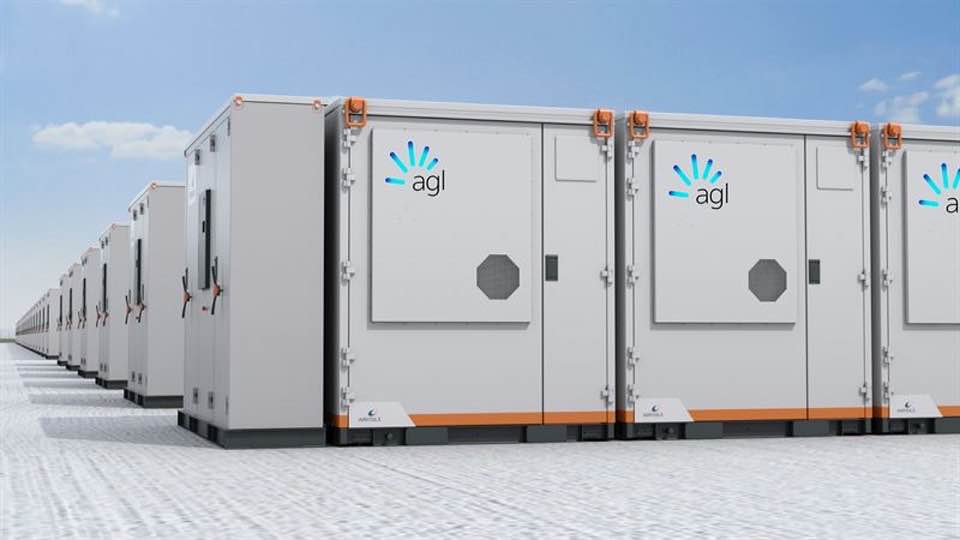
AGL has announced plans to deploy more than 850MW of grid-scale batteries by 2024. Image: AGL
Australian energy utility AGL confirmed at the weekend it has received approval from the New South Wales (NSW) Department of Planning and Environment (DPIE) to build a 500MW big battery, with up to four hours of storage, at the site of the soon-to-be-closed Liddell power plant near Muswellbrook in the Hunter Valley.
The grid-scale lithium-ion battery energy storage system is part of AGL’s plans to establish an integrated, low-carbon energy hub at the site of the ageing coal-fired generator that is to be shuttered early next year.
AGL said the first unit of Liddell is due to close next month, with the remaining three units to close in April 2023.
Planning documents indicate the big battery will have at least a 20-year operational life and will be built in three stages. The first phase of the project involves the installation of 150MW of battery storage. Work on Phase 1 is expected to be complete by the time the coal-fired plant shuts down.
NSW Treasurer Matt Kean said the Liddell battery would play an important role in supporting the transition of the energy sector to renewable power generation as coal-fired generation is increasingly withdrawn.
“Big batteries combined with solar, wind and pumped hydro will help to deliver some of the cheapest and most reliable energy to the families and businesses of NSW,” he said.
The approval of the Liddell big battery comes just weeks after AGL announced it had fast-tracked the closures of its two biggest coal-fired power plants by several years.

The first 150MW stage of the LIddell battery is expected to be installed by April 2023.Image: AGL
AGL said the 2,640MW Bayswater power station in the Hunter Valley will be shuttered “no later than” 2033, two years ahead of its previously scheduled closure of 2035, while the 2.210MW Loy Yang A plant in Victoria’s Latrobe Valley will now close by 2045 rather than 2048.
Fellow gen-tailer Origin Energy has also brought forward plans to close its coal-fired Eraring power station in the Hunter region, announcing last month the 2,880MW plant will be closed in August 2025, seven years earlier than previously scheduled.
AGL chief operating officer Markus Brokhof said the transition of the Liddell coal-fired power plant into a renewable energy hub would mark the company’s first rehabilitation of a thermal coal site.
“This planning approval marks a significant milestone for the transition of the Liddell site,” he said. “We look forward to working with partners to progress other developments on and around the site, including a wind farm, a solar storage system, pumped hydro, a waste-to-energy plant and our recently announced green hydrogen pilot with Fortescue Future Industries (FFI).”
The Liddell battery forms part of AGL’s plans to add 850MW of grid-scale batteries to its portfolio by 2024.
Construction had has already started on a 250MW/1GWh battery being developed at the site of its Torrens Island power station in South Australia.
It has also lodged a planning application to construct a 200MW/800MWh battery at its Loy Yang power station. AGL has already received the tick of approval from NSW planning authorities for a 50MW/100MWh battery in Broken Hill and has announced support for battery projects at Wandoan (100 MW) in Queensland and Maoneng (4 x 50MW) in NSW. It is already operating the 30 MW/8MWh BESS at Dalrymple in South Australia.

AGL has commenced the installation of a 250MW/1GWh battery at the site of its Torrens Island power station in SA.Image: DEM
Brokhof said firming technology like grid-scale battery storage would be critical to the ongoing integration of renewable sources into the national grid.
“As Australia moves forward and we increase our reliance on renewable generation, batteries will be critical in providing the storage needed to maintain a consistent, reliable and affordable energy system,” he said.
“All of these developments will benefit from the excellent resources and infrastructure these sites feature and create the jobs of the future across many industries, not just energy.
“This is a trend that is already happening overseas with more than 150 energy hub projects announced globally, all of them aimed at creating new business development opportunities and value creation.”
The planning approval for the Liddell battery comes as AGL continues to progress its plan to split into two listed entities – energy retailer AGL Australia and electricity generator Accel Energy – by June 30.
Under the proposal, AGL Australia would own its retailing division and some cleaner generation assets, while Accel Energy would house its fleet of coal- and gas-fired power stations.
As part of the demerger, AGL has outlined plans to diversify these thermal power sites into renewable energy hubs, which may include big batteries, hydrogen production and carbon capture and storage.
Earlier this month AGL rejected a $9 billion buyout offer from a consortium including software billionaire Mike Cannon-Brookes and Canada’s Brookfield Asset Management, saying the offer understated the value it believes will be unlocked through the demerger, including its vision for energy hubs.